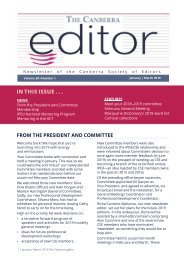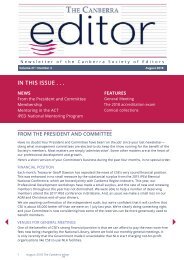ACTive Voice Feb–Apr 2020
Create successful ePaper yourself
Turn your PDF publications into a flip-book with our unique Google optimized e-Paper software.
Academic articles are written and read by a more educated audience, so
the language is more complex, often with specialist nomenclature.
Note to CSE members
CSE Committee is negotiating
whether and how CSE might
support members’ use of
VisibleThread.
As a preliminary step, we’re
seeking volunteers to test the
software in their businesses.
Some members who saw the
presentation are very keen to
use the software.
If you can see an opportunity
for this in your work, and
could trial it within the next
few weeks and report to
Committee, please contact
Eris Harrison via the
President email in ‘Contact
us’ on CSE’s website.
We’re limited to five
participants, so don’t mull
over it for too long.
Eris Harrison
Readability tools
Readability tools have come out of the shift towards plain English, with its
focus on shorter sentences, shorter words that people use everyday, and a
reduction in unnecessary words.
VisibleThread Readability is one such tool. It was initially created to make
tender documents easier to read and respond to. The company then
expanded to helping governments improve the readability of their
communications – e.g. websites, emails, letter or other content – largely in
Ireland, Australia, Canada and the U.S.
The tool evaluates text in terms of sentence length, the amount of passive
voice, readability (based on the Flesch Reading Ease Test), and it gives a
grade level equivalent. These metrics can be compared with a standard
that you set. This is where the real value of VisibleThread comes in: if your
audience will value an unlimited amount of passive voice, multisyllabic
words and 50-word sentences, you can set the standard accordingly.
In many departments, web publishing or communications areas set the
standard for an entire department. According to Brian, they use the
apparent impartiality of VisibleThread to explain why those 50-word
sentences they get asked to publish aren’t appropriate for a website: ‘it’s
not me rejecting your writing – it’s the machine’.
The Whitelist function lets you exclude unavoidable terms, such as the name
of your department, from the readability score. It also lets you create a list of
Watch Words that should be avoided, and can offer preferred alternatives.
Brian finished his talk with an example of how a NSW primary school
principal used VisibleThread to reduce her own workload in editing 150
school reports (that’s one for each child). Teachers would draft the
reports, send them to the principal for review, then make corrections as
required. All this on the evenings and weekends, of course.
With the help of VisibleThread, the principal found that she could save 105
hours a year just by highlighting complex language and jargon as teachers
write. She created a ‘watchwords’ list so VisibleThread could flag jargon
and offer an alternative (entered by the principal). It became an essential
part of the school’s style guide. It made the process more objective and
reduced the ‘red-pen arguments’. The resulting reports were more
consistent, easier to review, and for parents, easier to read.
How can it help editors?
For editors, VisibleThread is another tool we can use to deliver better
edited text. It’s more gentle in offering advice about the readability
metrics (such as sentence length and passive voice) than some other
readability tools. Its Whitelist function and the ability to adjust the
standards lets you customise the readability analysis for the client. (cont.)
page 14 of 16 ACTive Voice February–April 2020
















